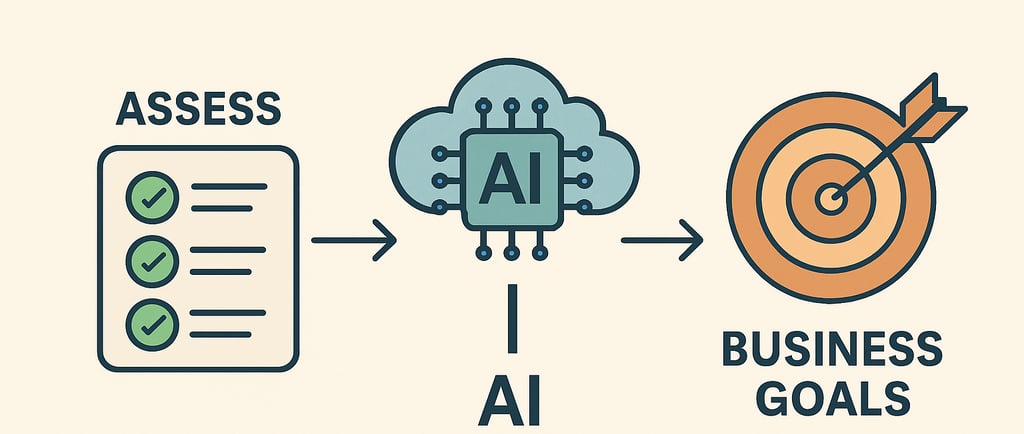How to Align AI Projects with Real Business Goals (and Actually Deliver Results)
Discover a practical, strategy-first approach to integrating AI into business operations. Learn how to assess goals, weigh benefits and risks, pilot initiatives, and scale AI responsibly — all through a business process lens. Perfect for startups, operators, and career strategists seeking measurable results without the hype.
LATESTCAREERSTARTUPS
Alexander Pau
10/18/20253 min read


Everyone’s Talking AI — Few Understand How to Use It
AI is everywhere. Every company talks about it, yet very few approach it strategically. Most conversations center on tools: dashboards, subscriptions, automation scripts — not measurable outcomes.
The gap is simple: people treat AI like a feature, not a process improvement. Teams jump to tools before understanding goals, workflows, and trade-offs. As I wrote in The Beginner’s Guide to AI: What Startups and Career Pivoters Actually Need to Know, AI is an amplifier. Without a clear process lens, it just scales inefficiency.
McKinsey’s State of AI in 2025 report confirms this: 70% of organizations are experimenting with AI, yet only 22% see measurable ROI. The differentiator isn’t technology; it’s alignment with strategy and workflows.
The Sharp Starts Framework: Assess, Align, Act
AI adoption mirrors business process improvement. My approach treats AI initiatives like any operational change: define the goal, map the workflow, weigh benefits and risks, test, integrate, then scale.
1. Assess — Map Goals, Benefits, and Risks
Start by understanding why AI might be applied. Questions to ask:
What are the top priorities this year?
Which key results or KPIs define success?
Which workflows are repetitive, error-prone, or slow?
What are the potential benefits of AI here - faster decisions, better insights, automation?
What are the risks - errors, adoption friction, misalignment, or unexpected cost?
AI succeeds only when it’s treated like any other process improvement: clear objectives, mapped workflows, measurable outcomes, and realistic understanding of trade-offs.
This approach parallels lessons from From Box Scores to OKRs: before optimizing, understand what success looks like and what drives it. Similarly, IBM stresses tying AI initiatives to business goals, not chasing shiny tools.
2. Pilot — Test Assumptions, Minimize Risk
Once you understand the potential benefits and risks, pilot small. Treat the pilot as a controlled experiment:
Identify a workflow with measurable impact.
Apply AI in a limited, low-risk manner.
Track actual results vs. expected outcomes.
MIT Sloan’s research on AI for frontline workers shows that AI adoption succeeds when users see immediate wins tied to daily work. Pilots are your opportunity to validate assumptions, reduce risk, and ensure the initiative actually delivers value.
3. Integrate — Make AI Part of the Workflow
Pilots fail if the process isn’t integrated. Integration is about:
Updating SOPs to include AI outputs
Assigning clear ownership
Training the team to use AI responsibly
Monitoring performance against KPIs
Process management is critical. As I discuss in The Sharp Starts Tracking Playbook, consistency and accountability make any system, AI included, sustainable.
At this stage, integration also involves continuous benefit and risk monitoring. Even if an AI tool adds value initially, new risks can emerge as teams scale usage. Tracking outcomes ensures AI is truly amplifying, not introducing new problems.
4. Scale — Connect AI to Business Outcomes
Scaling AI isn’t about deploying more tools, it’s about connecting processes, data, and teams:
Link workflows across systems to create a feedback loop
Expand proven use cases into new areas strategically
Monitor whether AI is impacting the KPIs it was meant to influence
McKinsey notes that AI realizes its full potential only when embedded across the operating model, not siloed. Scaling requires discipline, not flashy adoption metrics. It’s the same mindset that drives successful business process improvements: start small, ensure alignment, then scale methodically.
Operator’s Perspective: AI Mirrors Process Discipline
From my experience improving business processes, the lessons for AI are obvious:
Clarity first. Define goals, key results, and metrics.
Map before automating. Understand workflows and bottlenecks.
Weigh benefits vs. risks. Faster is not always better if errors increase or adoption lags.
Pilot before scaling. Treat AI like a controlled experiment.
Integrate responsibly. Make AI part of the operating rhythm, not a shiny side project.
AI amplifies the strengths, and exposes the weaknesses, of existing workflows. Teams that succeed aren’t chasing the latest model; they’re disciplined operators applying the same analytical lens they use on any process.
Closing Reflection
AI is not a magic bullet — it’s a mirror of your processes, priorities, and decision-making rigor. By applying the same analytical, operator mindset used in business process improvement, you can identify where AI actually adds value, measure its impact, and scale it responsibly.
The organizations that succeed with AI are those that combine clarity, structured assessment, risk awareness, and disciplined execution. That’s not flashy, but it’s effective. And it’s the kind of strategic thinking I bring to any business or team looking to integrate AI into operations while keeping outcomes measurable and meaningful.
📚Further Reading
Why Servant Leadership Is the Only Kind That Actually Works — Leadership style impacts adoption and the ability to integrate change like AI responsibly.
The Only Project Management Showdown You Need in 2025 — Practical frameworks for tracking initiatives and maintaining accountability in complex operational changes.
SEO That Won’t Drain Your Runway — Illustrates the principle of disciplined, sustainable adoption, analogous to implementing AI without hype.
TL;DR
AI adoption should start with clarity on business objectives and key results.
Treat AI like any other process improvement: map workflows, identify bottlenecks, and define success metrics.
Consider both benefits (efficiency, insights, scalability) and risks (errors, adoption gaps, misaligned expectations).
Pilot small initiatives to test assumptions before scaling.
Integration and scaling succeed when AI is tied to workflows and outcomes, not hype or tools.
